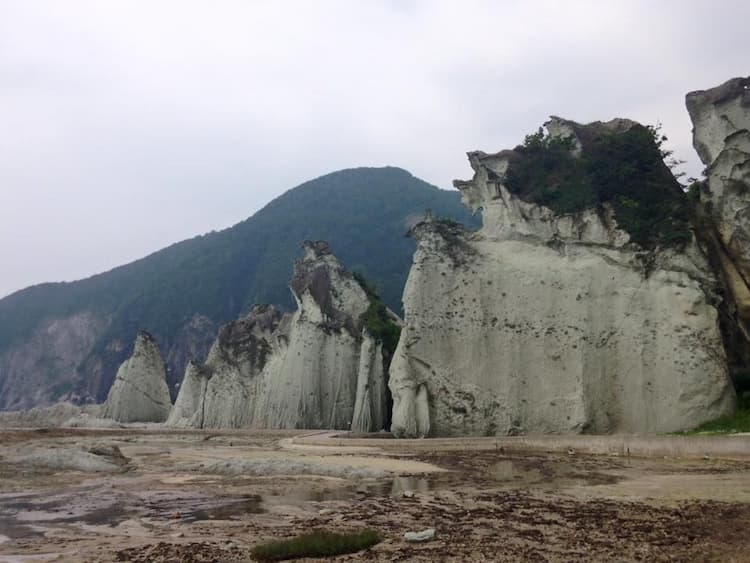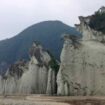
Go World Travel is reader-supported and may earn a commission from purchases made through links in this piece.
Venture out where misty hills meet the writhing sea. High mountain peaks dip into valleys of farmland. Monkeys terrorize fishing villages and bears break into homes. Come and see Japan’s hidden treasure; a hook of land that strikes out towards North Korea. This is the Sai peninsula of Aomori prefecture.
I lived in this part of the world for three years. My favorite thing to do was to drive around this area. Except in winter, it’s almost impossible; well, you can do it, but many sights are closed and the roads may be buried under meters of snow. Not advised.
Planning a last-minute trip to Japan?
Top Experiences and Tours in Japan:
- See the sights with a tour of Tokyo: Full-Day Private Tour with Nationally-Licensed Guide
- See Mount Fuji on the Private Full Day Sightseeing Tour to Mount Fuji and Hakone
- Explore more with this tour of Tokyo Half-Day Private Tour with Government-Licensed Guide
Where to stay in Japan:
- Find accommodation with Booking.com
- Find your dream apartment in Japan with Agoda
- Find a hostel in Japan with Hostelworld
Very few places in Japan offer an authentic “out in the middle of nowhere” feel. Most other mountainous or countryside areas will have settlements, convenience stores, and gas stations not too far away. Sai has these as well, in minimal supply. If you visit be sure to have plenty of gas in the tank and food/water on hand.
If you love nature, you enjoy driving, and you want to see a spot in Japan that no one ever visits, Sai is for you. here are some of the best things to do on your road trip.
The Buddha Rocks

The most physically striking sight is Hotokeguara, a collection of rocks that shoot straight out of the beach. Hotoke means “Buddha” and refers to the weird way the rocks have been formed. Each one looks like a natural impossibility of balancing heavier stones on top of lighter ones.
Some of them look like various figures from Buddhist history, thus the name. You park at the top of a long descending staircase through the forest to arrive at the beach. The area itself has wooden plank paths to follow but you can freely depart and walk around as you wish.
This destination is shut down during the winter. As I mentioned before, do not try a winter expedition to the area in general unless you are an expert in snow driving, even then I wouldn’t advise it.
During the rest of the year (April to October mainly), the roads are clear. You can take a ferry from Sai Village or Mutsu City, but I recommend driving there. The beauty of driving through the heart of the mountains and the woods is worlds above what you’d see from the ferry. A little more dangerous, the roads are winding, so be careful.
Best Tips & Tools to Plan Your Trip
Oma Port

Technically, it’s outside of Sai but it’s the same region. Oma is famous for tuna. In 2019 a single fish sold for $2.3 million!! Despite this insane price, I’ve been served tuna for free by kindly elderly women who were excited to see a foreign visitor to their shop. Not that you should expect that but it’s also not outside the realm of possibility.
Every shop along the coast sells sea-related items such as tuna, shark jaws, shells, old fishing lights, squid, and more. The main area of interest is Omazaki, which is the most northern point of Japan’s main island of Honshu. You can see the island of Hokkaido fairly easily from here; you can also take a ferry across, even with your car. Here is the website for the ferry (in English) with times and prices.
Oma has a series of festivals throughout the year. Check out their homepage for a full list. The best one to see is the Blue Marine Festival on August 4th. Hundreds of people (a lot for the area) converge on a marina where food stalls and games occur all day. At night, fireworks display rockets across the sky in such a way as to rival any I’ve ever seen in the US before. Dates for this event can change so please refer to their website before you make plans.
Onsen (Hot Springs)
Japan is famous for onsen. You can find one of these naturally occurring hot springs almost anywhere in the county. On the mountain drive of Sai, there are dozens of hidden onsen to discover.
Most likely you’ll be the only customer at these places, save for some elderly farmers. And unlike people in the bigger cities of Japan, they will try to talk to you. Many of the people out here are friendly and keenly interested when foreigners come to visit because they rarely do.
Note: The dialect in this part of Japan is difficult even for native Japanese speakers to understand. English is pretty much non-existent. Good luck.
My favorite of these hidden gems was Yunokawa onsen. Nestled deep in the mountains, it seems like no one lives in the area. Walk inside and you’ll find that the place is a fully operational and well-kept onsen. They have rotenburo (outside baths) where you can sit in absolute stillness, with a full view of the first before you.
Upon my last phone call (January 2024), this onsen was closed due to COVID but they may open again soon. Check the link above to see if that is the case should you venture out there. If it is closed, there are many more options, just input “onsen” into Google Maps and you’ll find some.
One word of caution: Don’t go in August because the horseflies are out and will devour you in the bath.
Aside from the onsen I mentioned, you can try and find others, they may or may not appear on Google Maps. But I would be careful, since this is a pretty wild area the ones you find may be no longer open, or not accessible by road. On that point, there are many places along the drive where you will not have phone service. Plan accordingly.
Wildlife Considerations

You may run into raccoon dogs (tanuki), my favorite odd animal. They look just like their names imply. Dog-shaped and sized but with some raccoon stripes around the eyes and an overly fluffy coat. They are nocturnal but I’ve seen them in the day. Harmless unless you try to pick them up.
You might, if you are lucky, run into a kamoshika. They are a type of serow, which I honestly don’t know what that means. Kind of like a deer….but they look like wolves. Very rare, fairly docile unless with their babies, and a treat to see.
Monkeys….are…everywhere. Another reason to drive instead of taking the ferry is that you most likely will run into a troop of monkeys on the road. Running into wild bands of monkeys can be exhilarating but do NOT try to engage them. Unlike monkeys in tourist areas, these are not used to humans and will most likely see you as a threat if you try to approach them.
In the heat of Japan’s brutal summer, the mountains provide a cool-down effect. During this time abu (giant horseflies) abound. Here’s a survivor’s tip: when you stop your car do NOT leave the windows open; else the horseflies fill up your car. They do bite.
There are also giant Asian hornets (suzumebachi) which can be dangerous if provoked. But if you walk by them calmly they won’t bother you.
The most dangerous animals you could encounter are bears. I grew up in northern California so I thought I could handle bears. The Japanese black bears are much smaller than what I was used to. But, they are also more aggressive than their bigger cousins.
Chances are you’ll never see one. I only had one encounter in three years of constantly going outside in the area and it ran away from me. Still, do not approach them, make sure you make noise if walking a wilderness trail, and don’t go alone.
Last Words

Aside from the specific places already mentioned, even just driving along the mountain roads of Sai is a meditative experience. You will be surrounded by natural majesty and wildlife at every turn. So even if you don’t travel to one of these points of interest, you can still have an enjoyable time just by being there.
If you want a break from the chaos of Tokyo, come out to Sai, there’s plenty of room.
Inspire your next adventure with our articles below:
Author Bio: Shawn hails from the mountain town of South Lake Tahoe and currently resides in Japan. He has been there for 11 years, speaks the language fluently, and works as a history teacher by day. In his spare time, when not running with his Husky, he writes non-fiction travel articles/books and horror fiction ones.
- Discover Claremont, California Along Historic Route 66 - December 6, 2024
- Three Sites to Soothe the Soul in Kyoto, Japan - December 5, 2024
- 13 Essential Tips For Women Traveling in Morocco - December 4, 2024


Wonderfully written. It really makes me want to visit.